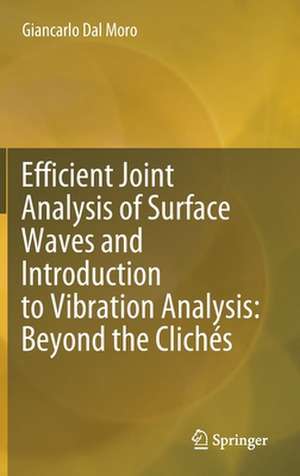Efficient Joint Analysis of Surface Waves and Introduction to Vibration Analysis: Beyond the Clichés
Autor Giancarlo Dal Moroen Limba Engleză Hardback – 21 iun 2020
It demonstrates how surface waves (used to define the VS profile) and vibration data (used to describe the dynamic behaviour of a building) can be recorded using the same equipment, and also highlights common problems, ambiguities and pitfalls that can occur when adopting popular methodologies, which are often based on a series of simplistic assumptions.
Today, most national and international building codes take into account a series of parameters aimed at defining the local seismic hazard. Sites are characterised based on the local VS profile, and the dynamic behaviour of existing buildings is defined through the analysis of their eigenmodes. The book includes a series of case studies to help readers gain a deeper understanding of seismic and vibration data and the meaning (pros and cons) of a series of techniques often referred to as MASW, ESAC, SPAC, ReMi, HVSR, MAAM and HS. It also provides access to some of the datasets so that readers can gain a deeper and more concrete understanding of both the theoretical and practical aspects.
Preț: 896.00 lei
Preț vechi: 1092.68 lei
-18% Nou
Puncte Express: 1344
Preț estimativ în valută:
171.47€ • 186.19$ • 144.03£
171.47€ • 186.19$ • 144.03£
Carte tipărită la comandă
Livrare economică 23 aprilie-07 mai
Preluare comenzi: 021 569.72.76
Specificații
ISBN-13: 9783030463021
ISBN-10: 3030463028
Ilustrații: XIII, 266 p. 225 illus., 210 illus. in color.
Dimensiuni: 155 x 235 mm
Greutate: 0.59 kg
Ediția:1st ed. 2020
Editura: Springer International Publishing
Colecția Springer
Locul publicării:Cham, Switzerland
ISBN-10: 3030463028
Ilustrații: XIII, 266 p. 225 illus., 210 illus. in color.
Dimensiuni: 155 x 235 mm
Greutate: 0.59 kg
Ediția:1st ed. 2020
Editura: Springer International Publishing
Colecția Springer
Locul publicării:Cham, Switzerland
Cuprins
Preface
Chapter 1 - Introduction: a miscellanea
Chapter 2 - Surface-wave analysis beyond the dispersion curves: FVS
Chapter 3 – HVSR, amplifications and ESAC: some clarifications
Chapter 4 - New trends: HS, MAAM and beyond
Chapter 5 – Introduction to vibration monitoring and building characterization via GHM
Chapter 6 - Some final remarks and recommendations
Chapter 1 - Introduction: a miscellanea
Chapter 2 - Surface-wave analysis beyond the dispersion curves: FVS
Chapter 3 – HVSR, amplifications and ESAC: some clarifications
Chapter 4 - New trends: HS, MAAM and beyond
Chapter 5 – Introduction to vibration monitoring and building characterization via GHM
Chapter 6 - Some final remarks and recommendations
Notă biografică
Prof. Giancarlo Dal Moro graduated in Geological Sciences and holds a Ph.D. in Geophysics. He has worked as a researcher in Italy and abroad and published numerous papers in peer-reviewed journals. In addition to his academic activities, since 2006 he has also been involved in the data acquisition and analysis for a large number of projects and the design of innovative procedures for the acquisition and analysis of seismic data (patented methodology for surface-wave acquisition and analysis based on the exploitation of a single 3-component geophone). He currently works in Prague, at the Institute of Rock Structure and Mechanics of the Academy of Sciences of the Czech Republic.
Textul de pe ultima copertă
This book bridges the gap between theory and practice, showing how a detailed definition of the shear-wave velocity (VS) profile can be efficiently obtained using limited field equipment and following simple acquisition procedures.
It demonstrates how surface waves (used to define the VS profile) and vibration data (used to describe the dynamic behaviour of a building) can be recorded using the same equipment, and also highlights common problems, ambiguities and pitfalls that can occur when adopting popular methodologies, which are often based on a series of simplistic assumptions.
Today, most national and international building codes take into account a series of parameters aimed at defining the local seismic hazard. Sites are characterised based on the local VS profile, and the dynamic behaviour of existing buildings is defined through the analysis of their eigenmodes. The book includes a series of case studies to help readers gain a deeper understanding of seismic and vibration data and the meaning (pros and cons) of a series of techniques often referred to as MASW, ESAC, SPAC, ReMi, HVSR, MAAM and HS. It also provides access to some of the datasets so that readers can gain a deeper and more concrete understanding of both the theoretical and practical aspects.
It demonstrates how surface waves (used to define the VS profile) and vibration data (used to describe the dynamic behaviour of a building) can be recorded using the same equipment, and also highlights common problems, ambiguities and pitfalls that can occur when adopting popular methodologies, which are often based on a series of simplistic assumptions.
Today, most national and international building codes take into account a series of parameters aimed at defining the local seismic hazard. Sites are characterised based on the local VS profile, and the dynamic behaviour of existing buildings is defined through the analysis of their eigenmodes. The book includes a series of case studies to help readers gain a deeper understanding of seismic and vibration data and the meaning (pros and cons) of a series of techniques often referred to as MASW, ESAC, SPAC, ReMi, HVSR, MAAM and HS. It also provides access to some of the datasets so that readers can gain a deeper and more concrete understanding of both the theoretical and practical aspects.
Caracteristici
Presents innovative methodologies for the efficient acquisition and analysis of surface waves and the robust definition of the VS profile
Building vibration analysis for the definition of the characteristics of the eigenmodes
Includes a series of multi-component datasets to download and analyze for your training
Building vibration analysis for the definition of the characteristics of the eigenmodes
Includes a series of multi-component datasets to download and analyze for your training
